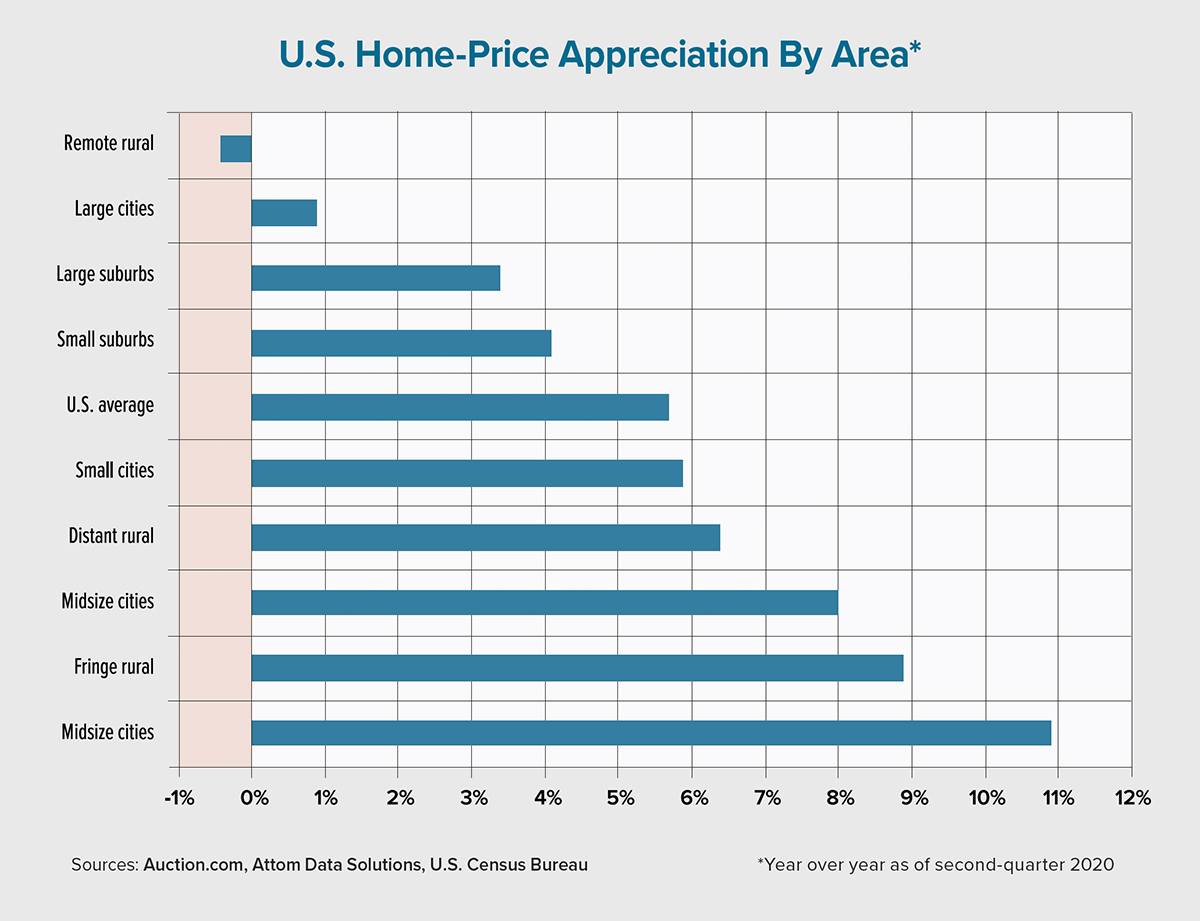The coronavirus pandemic is amplifying and altering a U.S. real estate trend driven by shifting population migration patterns in recent years. This trend involves slackening demand for homes in high-cost and high-density urban areas, mainly those located on the coasts, and is countered by rising demand for the lower-priced homes and suburban sprawl more commonly found in the nation’s interior markets.
Evidence of this trend showed up in a recent report on New York City’s market by real estate brokerage Douglas Elliman. In second-quarter 2020, Manhattan home sales dropped by 54% while median home prices declined by 17.7% from a year earlier, according to the report.
An Auction.com analysis of public-record sales data from Attom Data Solutions, along with urban and rural classification data from the U.S. Census Bureau, shows evidence of below-average home-price appreciation in large cities and large suburbs. Meanwhile, small and midsize cities, midsize suburbs and rural areas on the fringes of cities experienced above-average appreciation.
The analysis looked at second-quarter 2020 home sales and annual home-price appreciation in more than 8,000 ZIP codes with at least five home sales in the second quarters of both 2019 and 2020. The average year-over-year appreciation was less than 1% for ZIP codes located in large cities and 3.4% for ZIP codes located in large suburbs (both defined by the census bureau as having at least 250,000 residents). Both figures were well below the average appreciation of 5.7% for all ZIP codes analyzed.
ZIP codes in midsize cities (those with a population between 100,000 and 250,000) posted average annual appreciation of 10.9%, the highest of any census classification included in the analysis. Fringe rural areas, those that are within five miles of an urbanized area, followed at 8.9%, while midsize suburbs with populations between 100,000 and 250,000 averaged 8% appreciation.
An exodus from high-cost, high-density coastal markets such as New York City was already in progress before the pandemic, according to 2019 population migration data from the census bureau. The borough of Manhattan lost 5,003 people to migration for the 12-month period ending in July 2019, representing 0.31% of its population. This net migration total included an 11,000-person loss to domestic migration (people moving to other parts of country) that was partially offset by 6,700 people added through international migration (people moving there from outside of the country).
Each of the five counties posting the largest net migration decreases in 2019 were located in the nation’s three largest metro areas: New York City, Los Angeles and Chicago. Conversely, each of the five counties that posted the largest net migration increases in 2019 were located in metro areas known for low-density housing and suburban sprawl: Phoenix, Las Vegas, Dallas and Austin.
Other factors, such as weather and taxes, have certainly helped to drive this recent migration trend from larger to smaller markets. The pandemic, however, has added more fuel to this fire given the potential health risks of living in high-density housing environments. There also is a broader acceptance of working remotely.
Real estate investors are adapting to this population shift, according to proprietary data from Auction.com. In the second quarter of this year, the sales rates for both foreclosure auctions and online real estate owned (REO) auctions via the Auction.com platform were highest for properties located in suburbs. A year ago, in second-quarter 2019, the sales rates for each of these categories were highest for properties located in cities.
The sales rate for online REO auctions increased by 8% year over year for properties located in suburbs, while the sales rate for properties in cities decreased by 7%. Across the board, foreclosure sales rates increased, but the largest jump was for properties located in suburbs (up 34%). Foreclososure properties in cities saw a 17% sales increase while those in rural areas jumped by 14%. ●
Author
-

Daren Blomquist is vice president of market economics at Auction.com. In this role, Blomquist analyzes and forecasts complex macroeconomic and microeconomic data trends to provide value to both buyers and sellers using the platform. Blomquist has been cited by thousands of media outlets nationwide, including major news networks, The Wall Street Journal, The New York Times and USA Today. Prior to Auction.com, Blomquist worked at Attom Data Solutions.
View all posts






